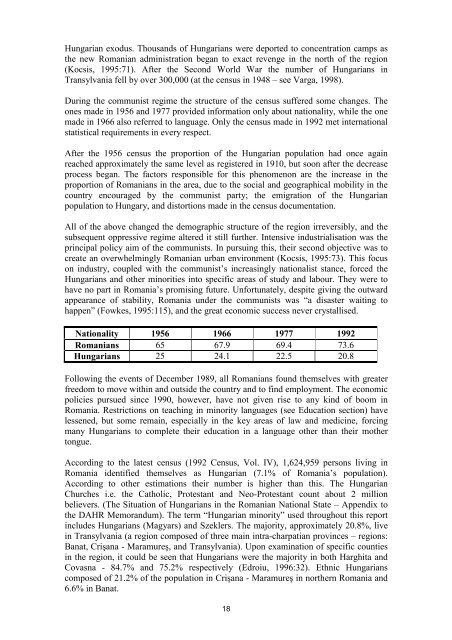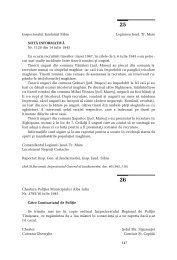Southeast Europe
Southeast Europe
Southeast Europe
You also want an ePaper? Increase the reach of your titles
YUMPU automatically turns print PDFs into web optimized ePapers that Google loves.
Hungarian exodus. Thousands of Hungarians were deported to concentration camps as<br />
the new Romanian administration began to exact revenge in the north of the region<br />
(Kocsis, 1995:71). After the Second World War the number of Hungarians in<br />
Transylvania fell by over 300,000 (at the census in 1948 – see Varga, 1998).<br />
During the communist regime the structure of the census suffered some changes. The<br />
ones made in 1956 and 1977 provided information only about nationality, while the one<br />
made in 1966 also referred to language. Only the census made in 1992 met international<br />
statistical requirements in every respect.<br />
After the 1956 census the proportion of the Hungarian population had once again<br />
reached approximately the same level as registered in 1910, but soon after the decrease<br />
process began. The factors responsible for this phenomenon are the increase in the<br />
proportion of Romanians in the area, due to the social and geographical mobility in the<br />
country encouraged by the communist party; the emigration of the Hungarian<br />
population to Hungary, and distortions made in the census documentation.<br />
All of the above changed the demographic structure of the region irreversibly, and the<br />
subsequent oppressive regime altered it still further. Intensive industrialisation was the<br />
principal policy aim of the communists. In pursuing this, their second objective was to<br />
create an overwhelmingly Romanian urban environment (Kocsis, 1995:73). This focus<br />
on industry, coupled with the communist’s increasingly nationalist stance, forced the<br />
Hungarians and other minorities into specific areas of study and labour. They were to<br />
have no part in Romania’s promising future. Unfortunately, despite giving the outward<br />
appearance of stability, Romania under the communists was “a disaster waiting to<br />
happen” (Fowkes, 1995:115), and the great economic success never crystallised.<br />
Nationality 1956 1966 1977 1992<br />
Romanians 65 67.9 69.4 73.6<br />
Hungarians 25 24.1 22.5 20.8<br />
Following the events of December 1989, all Romanians found themselves with greater<br />
freedom to move within and outside the country and to find employment. The economic<br />
policies pursued since 1990, however, have not given rise to any kind of boom in<br />
Romania. Restrictions on teaching in minority languages (see Education section) have<br />
lessened, but some remain, especially in the key areas of law and medicine, forcing<br />
many Hungarians to complete their education in a language other than their mother<br />
tongue.<br />
According to the latest census (1992 Census, Vol. IV), 1,624,959 persons living in<br />
Romania identified themselves as Hungarian (7.1% of Romania’s population).<br />
According to other estimations their number is higher than this. The Hungarian<br />
Churches i.e. the Catholic, Protestant and Neo-Protestant count about 2 million<br />
believers. (The Situation of Hungarians in the Romanian National State – Appendix to<br />
the DAHR Memorandum). The term “Hungarian minority” used throughout this report<br />
includes Hungarians (Magyars) and Szeklers. The majority, approximately 20.8%, live<br />
in Transylvania (a region composed of three main intra-charpatian provinces – regions:<br />
Banat, Crişana - Maramureş, and Transylvania). Upon examination of specific counties<br />
in the region, it could be seen that Hungarians were the majority in both Harghita and<br />
Covasna - 84.7% and 75.2% respectively (Edroiu, 1996:32). Ethnic Hungarians<br />
composed of 21.2% of the population in Crişana - Maramureş in northern Romania and<br />
6.6% in Banat.<br />
18









